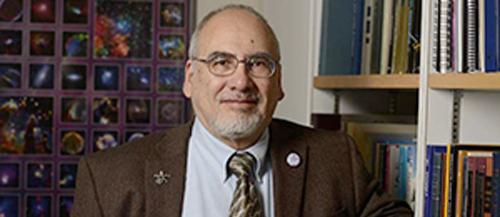- Telescopes
- Detector Technology
- Quasars & Other Active Black Holes
- Galaxy Clusters
- Large Scale Structure

Cambridge, MA -
Prominent astrophysicist Stephen (Steve) S. Murray died on Monday, August 10, 2015. Dr. Murray is widely recognized for advancing the field of high-energy astrophysics through the development of instruments and hardware as well as his research.
After beginning his career at American Science & Engineering in Cambridge, Mass. in 1970, Dr. Murray joined the newly formed High Energy Division of the Harvard-Smithsonian Center for Astrophysics (CfA) in 1973, where he stayed for more than forty years.
“Steve helped me greatly when I first took up my position here as director, in his role as the Deputy Director for Science,” said Charles Alcock, Director of the CfA, Cambridge MA. “We collaborated scientifically and also became good friends, and I feel this loss keenly.”
During his long and distinguished career at the CfA, Steve worked on four major high-energy missions, starting with Uhuru. He built instruments for Einstein in the 1970s, ROSAT in the 1980s, and most recently for the Chandra X-ray Observatory, for which he was Principal Investigator for the High-Resolution Camera, one of the two imaging detectors that enable spectacular high-resolution images from Chandra.
“I had the privilege of working with Steve for the past 45 years spanning X-ray missions from UHURU to Einstein to Chandra. He was incredibly skilled and creative in advancing X-ray instrumentation,” said Harvey Tananbaum, former Director of the Chandra X-Ray Center. “Steve was equally adept working with computer hardware and software for analyzing instrument performance and astronomical data.”
“The X-ray community has lost one of the best experimental scientists who was able to make his contributions count,” said Martin Weisskopf, the Chandra Project Scientist at the Marshall Space Flight Center in Huntsville, Ala. “Steve’s experimental wizardry has had a profound impact on astronomy and astrophysics.”
Along with the Hubble Space Telescope, the Spitzer Space Telescope, and the now de-orbited Compton Gamma-ray Observatory, Chandra is one of NASA’s “Great Observatories” and considered to be the agency’s flagship mission for X-ray astronomy.
"The HRC provides the highest spatial and timing resolution and the largest field of view available on Chandra,” said CXC Director Belinda Wilkes. “As principal investigator, Steve and his team provide excellent support for HRC operations and maintenance, as well as carrying out ground-breaking science. His loss will leave a major hole in our team and I will miss him."
In addition to his work on instrumentation, Dr. Murray maintained many other research interests, including active galactic nuclei, clusters of galaxies, large-scale structure and cosmology.
“Steve was passionate about his family, friends, the New England Patriots, instrumentation and astrophysics, especially X-ray surveys,” said CfA astrophysicist William Forman. “He carried out the largest area, contiguous Chandra survey that covered nine square degrees and provided several fundamentally important results.”
“This survey showed how AGN host galaxies evolved over the last 9 billion years, proved that AGN map large scale structures, and discovered that X-ray AGN are usually located in the cores of massive galaxies,” said astrophysicist Christine Jones, also of the CfA. “These advances led to new and deeper understanding of how supermassive black holes grew and evolved over cosmic time. Steve was a great friend to us as well as a wonderful scientific colleague. He left us much too soon.”
Dr. Murray was also the principal investigator for NASA’s Astrophysics Data System, which provides free access to published literature in astronomy and astrophysics.
“His leadership in establishing the Astrophysics Data System provided one of the most important tools used so often by so many in our community” said Tananbaum. “For me personally and for the community overall, his passing away is a tragic loss.”
Dr. Murray took a leadership role in administration as well, serving as the Associate Director of the High-Energy Astrophysics Division, leader of the Center for X-ray Technology, and Deputy Director for Science for the Harvard-Smithsonian Center for Astrophysics.
In recent years, Dr. Murray was a senior researcher at the Space Telescope Science Institute and a research professor at the Johns Hopkins University, teaching undergraduates as well as continuing his work on the development of advanced imaging detectors for future high-energy missions.
Regarding future astronomical missions, Dr. Murray was the principal investigator for the Wide Field X-ray Telescope concept study. He returned recently to the CfA as the deputy principal investigator for the Whipple mission, an outer Solar System mission that was recently awarded technology funding from NASA.
Dr. Murray was born in New York City in 1944 and received his undergraduate degree in physics from Columbia University in 1965. In 1971, he was awarded a doctorate in physics from the California Institute of Technology.
NASA's Marshall Space Flight Center in Huntsville, Alabama, manages the Chandra program for NASA's Science Mission Directorate in Washington. The Smithsonian Astrophysical Observatory in Cambridge, Massachusetts, manages Chandra's science and flight operations.
Headquartered in Cambridge, Mass., the Harvard-Smithsonian Center for Astrophysics (CfA) is a joint collaboration between the Smithsonian Astrophysical Observatory and the Harvard College Observatory. CfA scientists, organized into six research divisions, study the origin, evolution and ultimate fate of the universe.
For more information, contact:
Megan Watzke
Chandra X-ray Center, Cambridge, Mass.
617-496-7998
mwatzke@cfa.harvard.edu
Christine Pulliam
Media Relations Manager
Harvard-Smithsonian Center for Astrophysics
617-495-7463
cpulliam@cfa.harvard.edu
Related News
CfA Selects Contractor for Next Generation Event Horizon Telescope Antennas
Can Cosmic Inflation be Ruled Out?
Astronomers May Have Discovered the First Planet Outside of Our Galaxy
Gravitational Self-Lensing of Massive Black Hole Binaries
Latest Results from Cosmic Microwave Background Measurements
"X-Ray Magnifying Glass" Enhances View of Distant Black Holes
Projects
AstroAI
GMACS
For Scientists